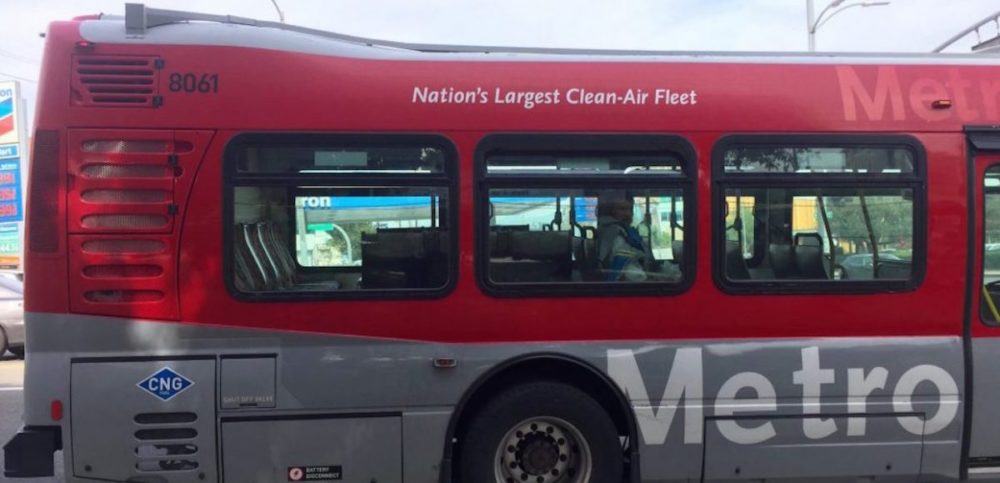Update, August 3rd 2017: LA Metro committed to 100% zero-emission buses by 2030! This is a big win for clean air and local jobs! Here’s the resolution.
Today, Los Angeles Metro, the second largest transit agency in the United States, will vote on a plan to transition its fleet to zero-emission buses. If this sounds familiar, you’re right. It looked as though Metro would vote on this in June, but the vote got bumped to July.
Leading up to last month’s vote, Joel Espino from The Greenlining Institute and I blogged about the importance of this commitment and Metro’s leadership on clean vehicles. Metro’s decision will impact Los Angeles’ efforts to clean the air, fight climate change, and expand economic opportunity. We applaud the proposal put forward by Metro staff to transition the entire fleet to zero-emission vehicles.
So what else has happened in electric bus news this past month? Let’s catch up:
Major labor agreement announced
Last week, Jobs to Move America and BYD, an electric truck and bus manufacturer in Lancaster, California, announced commitments by BYD to create job pathways for underrepresented and underserved populations in Los Angeles County.
The legally enforceable agreement includes a hiring commitment for 40 percent of BYD’s workers to be from populations facing barriers to employment, such as veterans and returning citizens; creation of training and apprenticeship programs for metal work, electrical wiring, and vehicle assembly; and job retention efforts such as transportation options for workers without a car. This agreement sets an excellent precedent for creating good, accessible jobs in the electric vehicle industry.
ARB analysis shows electric buses are cost competitive today
Last month, the California Air Resources Board (ARB) released a draft analysis for the total cost of ownership for electric buses. This analysis takes everything into account from the purchase of a bus to its maintenance and electricity costs.
ARB found that the total cost of owning a battery electric bus in Los Angeles is on par with a compressed natural gas (CNG) bus. Metro’s fleet is entirely CNG today. The spreadsheet released by ARB will be an excellent resource as transit agencies in California and elsewhere analyze the potential financial savings from electric buses.

Life cycle emissions analysis shows benefits of electric buses operated by Metro
Our life cycle emissions analysis of electric buses here, here, and here shows that on today’s grid in California, battery electric vehicles are the cleanest option. But what about for LA Metro, which has 9 of 11 bus depots that get electricity from the Los Angeles Department of Water and Power (DWP)?
DWP serves as its own grid operator or “balancing authority,” meaning it oversees electricity generation to meet demand within its service territory. So, a bus charged with electricity provided by DWP will have a different amount of life cycle global warming emissions than a bus charged with electricity from another part of the state (e.g. balanced by the California Independent System Operator).
Concerns have been raised by various groups that DWP’s current power mix, which relies on 24 percent coal (compared to 7 percent in the rest of the state), would neutralize any emissions reductions from the addition of electric buses to LA Metro’s fleet.
Using data from DWP’s Integrated Resource Plan and correspondence with their engineers, we found that on DWP’s grid today, life cycle global warming emissions for an electric bus are significantly lower than emissions from Metro’s current fleet of natural gas buses.
As DWP’s grid gets cleaner (notably with the phase out of coal by 2025 and increasing fraction of renewables to 55 percent by 2030), the life cycle global warming emissions will decrease even further (see graph above).
Metro’s proposal calls for 105 electric buses to be deployed in the next few years and the bulk of its electric buses to be deployed after 2020, meaning life cycle emissions are best represented by DWP’s grid post-2020.

Even more electric bus news in California…
- AC Transit (Alameda County) recently announced one of its 13 fuel cell buses achieved 25,000 hours of service, far surpassing the expected 4,000 hours and illustrating the durability of fuel cells and electric drive trains.
- The National Renewable Energy Laboratory released its second report on Foothill Transit’s (San Gabriel Valley) electric bus fleet. The report found maintenance and fuel costs for electric buses were similar if not lower than natural gas buses. The fuel efficiency of electric buses also showed an eight-fold improvement over natural gas buses operating on the same route. Averaged over all routes, battery electric buses showed a four-fold improvement in fuel efficiency over natural gas buses.
- And just yesterday, Proterra opened its West Coast battery electric bus manufacturing facility in the City of Industry outside of Los Angeles, expanding the company’s current capacity with its East Coast manufacturing facility in South Carolina and a battery facility in the San Francisco Bay Area.
This is an exciting time for clean vehicles and public transit. We encourage Metro to seize the opportunity to be a leader in fighting global warming and air pollution by adopting a strong plan to transition to zero-emission buses.

